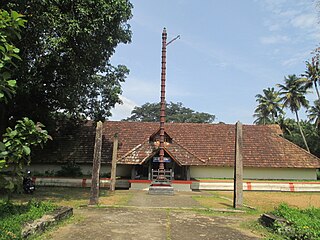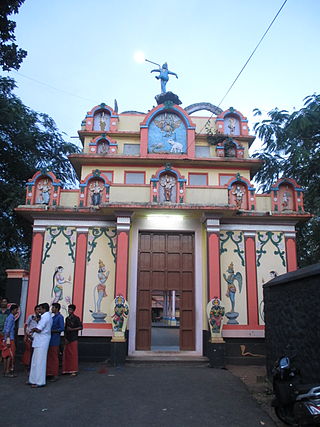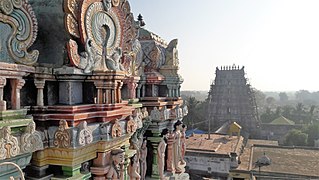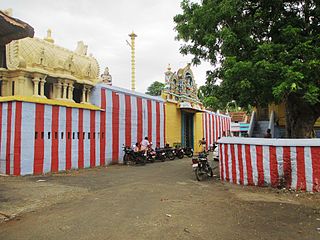
The Adikesava Perumal Temple is a Hindu temple located in Thiruvattar, Kanyakumari district, Tamil Nadu, India and is one of the 108 Divya desams, the holy sites of Hindu Vaishnavism according to existing Tamil hymns from the seventh and eighth centuries C.E. The temple is one of the historic thirteen Divya Deshams of Malai Nadu. The temple is a picturesque setting surrounded on three sides by rivers namely, It was the Rajya Temple and Bharadevatha shrine of Erstwhile Travancore. After state reorganisation, the temple handed over to Tamilnadu H&RCE Dept. The presiding Vishnu in the form of Ananthapadmabhan/Adikeshavaperumal is believed to be older than Padmanabhaswamy Temple in Thiruvananthapuram. Since Vishnu resides here in a reclining position, and is surrounded by rivers, the temple is called as "The Srirangam of Chera Kingdom".

Even though the deity as Rama, in the 'thanthrik' context, believers consider the deity as "Thevar" who participate in fishing pond, in their agriculture activities building check dam for paddy cultivation, who inaugurates seasonal plough of land and so on.

The Vilwadrinatha Temple is a Hindu temple in Thiruvilwamala, a town in the city of Thrissur, Kerala, India. The principal deities are Rama, the seventh incarnation of the god Vishnu, and his brother, Lakshmana. It figures among the Abhimana Kshetrams in Vaishnavite traditions. This is one of the four major Rama temples in Kerala — the other three are in Thriprayar, Kadavallur, and Thiruvangad. The temple houses an idol of Lakshmana, which is rare in India. Vilwadrinatha Temple is located in the centre of the community of Thiruvilwamala, atop a 100-foot-high hillock. Visible from the temple is Bharathappuzha, the second-largest river in Kerala, which flows past the temple's northern side from around 3 kilometres away.

Veeraraghava Swamy Temple is a temple dedicated to the Hindu god Vishnu, located in Tiruvallur, Chennai Metropolitan City, an area and headquarters in Tiruvallur district in the South Indian state of Tamil Nadu. Constructed in Dravidian style of architecture, the temple is glorified in the Divya Prabandham, the early medieval Tamil canon of the Alvar saints from the 6th–9th centuries CE. It is counted as one among the 108 Divya Desams dedicated to Vishnu. Vishnu is worshipped as Veeraraghava Perumal, and his consort Lakshmi as Kanakavalli Thayar.

Sthalasayana Perumal Temple is a Hindu temple dedicated to the god Vishnu located near Kollumangudi, Tamil Nadu, India. It is located 2 km away from Kollumangudi, 40 km away from Kumbakonam and 10 km from Karaikal. Constructed in the Dravidian style of architecture, the temple is glorified in the Nalayira Divya Prabandham, the early medieval Tamil canon of the Alvar saints from the 6th–9th centuries CE. It is one of the 108 Divya Desams dedicated to Vishnu, who is worshipped as Sthalasayana Perumal and his consort Lakshmi as Thirumagal Nachiyar. A granite wall surrounds the temple, enclosing all the shrines. There is a four-tiered rajagopuram, the temple's gateway tower, in the temple.

Nalambalam is a set of four Hindu temples in Kerala. In Malayalam, Nalu means "four" and Ambalam means "temple". These are the temples for the Rama and his brothers. There are around five sets of Nalambalams in Kerala, the most famous among them being the four temples located in Thrissur and Ernakulam districts, namely Thriprayar Sree Rama Temple, Koodalmanikyam Bharatha Temple, Moozhikkulam Lakshmana Temple and Payyammal Shathrughna Temple.

Nachiyar Kovil or Thirunarayur Nambi Temple is a Hindu temple in Thirunarayur, a village in the outskirts of Kumbakonam in the southern Indian state of Tamil Nadu, is dedicated to the Hindu god Vishnu and his wife Lakshmi. It is the sub urban region of business city of Kumbakonam.

Tirupavalavannam or Pavalavanam temple located in Kanchipuram in the South Indian state of Tamil Nadu, is dedicated to the Hindu god Vishnu. Constructed in the Dravidian style of architecture, the temple is glorified in the Nalayira Divya Prabandham, the early medieval Tamil canon of the Alvar saints from the 6th–9th centuries CE. It is one of the 108 Divya Desams dedicated to Vishnu, who is worshipped as Pavalavannar Perumal and his consort Lakshmi as Pavalavalli.

The Saranathan Temple in Thirucherai, a village on the outskirts of Kumbakonam in the South Indian state of Tamil Nadu, is dedicated to the Hindu god Vishnu. The temple is glorified in the Nalayira Divya Prabandham, the early medieval Tamil canon of the Alvar saints from the 6th–9th centuries CE. It is one of the 108 Divya Desams dedicated to Vishnu, who is worshipped as Saranathan and his consort Lakshmi as Saranayaki. It is believed that Saranathan appeared for Kaveri, the river goddess, who performed penance at this place.

Thiruthetriyambalam or Palli Konda Perumal Temple is located in Tirunangur, a village in the outskirts of Sirkaḻi in the South Indian state of Tamil Nadu, is dedicated to the Hindu god Vishnu. Constructed in the Dravidian style of architecture, the temple is glorified in the Nalayira Divya Prabandham, the early medieval Tamil canon of the Alvar saints from the 6th–9th centuries CE. It is one of the 108 Divya Desams dedicated to Vishnu, who is worshipped as Palli Konda Perumal.

Thanjai Mamani Koil is a set of three adjacent Hindu temples dedicated to Vishnu located in Thanjavur, Tamil Nadu, India. It is one of the Divya Desams, the 108 temples of Vishnu revered by the 12 poet saints called the Alvars. Unlike other Divya Desams where a single shrine is referenced, this set of temples is referred together in all the pasurams.

Thiruvaragunamangai Perumal Temple is one of the Nava Tirupati, the nine Hindu temples dedicated to Vishnu located in the Tiruchendur-Tirunelveli route, Tamil Nadu, India in the banks of Thamiraparani river. All these 9 temples are classified as Divya Desams, the 108 temples of Vishnu revered by the 12 poet-saints of the Sri Vaishnava tradition, called the Alvars. The temple at Natham also known Chandran Sthalam, the second of the Nava Tirupatis. Constructed in the Dravidian style of architecture, the temple is dedicated to Vishnu who is worshipped as Vijayasana Perumal and Lakshmi as Varagunavalli.

The Thirupuliyangudi Perumal Temple is one of the Nava Tirupati, the nine Hindu temples dedicated to Vishnu located in Tiruchendur-Tirunelveli route, Tamil Nadu, India in the banks of Thamiraparani river, in the South Indian state of Tamil Nadu. It is dedicated to the Hindu god Vishnu who is worshipped as Bhumipalar and Lakshmi as Pulingudivalli. It is located 22 km from Tirunelveli. Constructed in the Dravidian style of architecture, the temple is glorified in the Nalayira Divya Prabandham, the early medieval Tamil canon of the Alvar saints from the 6th–9th centuries CE. It is one of the 108 Divya Desams dedicated to Vishnu. The temple is also classified as a Nava Tirupati, the nine temples revered by Nammalvar located in the banks of Tamiraparani river. The temple is one of the Navagraha temples in the region, associated with Budha.

Vaithamanidhi Permual Temple is one of the nine Nava Tirupathi, the Hindu temples dedicated to Vishnu. It is located on the Tiruchendur–Tirunelveli route in Tamil Nadu, India, on the southern bank of the Thamiraparani River, 4 km from Alwarthirunagari. It is the eighth temple of Nava Tirupathi, and is named after Mars (Sevvai) and also called Kuberasthalam. Constructed in the Dravidian style of architecture, the temple is glorified in the Nalayira Divya Prabandham, the early medieval Tamil canon of the Alvar saints from the 6th–9th centuries CE. It is one of the 108 Divya Desams dedicated to Vishnu, who is worshipped as Vaithamanidhi Perumal and his consort Lakshmi as Kolurvalli.

The Thrichittatt Mahavishnu Temple is a Hindu temple dedicated to Vishnu,located in Chengannur, Alappuzha District, Kerala, South India. Constructed in the Kerala style of architecture, the temple is glorified in the Nalayira Divya Prabandham, by Nammalvar, one of the Sri Vaishnava saint-poets of the 8th century called the Alvars. It is one of the 108 Divya Desams dedicated to Krishna, an avatar of Vishnu, who is worshipped as Imayavarappan. The nearest railway station to the temple is located in Chengannur, while the nearest airports are Trivandrum International Airport and Nedupumpassery Airport Ernakulam.

The Thripuliyoor Mahavishnu Temple is a Hindu temple dedicated to Vishnu and located in Puliyoor, Alappuzha District, Kerala, South India. Constructed in the Kerala style of architecture, the temple is glorified in the Nalayira Divya Prabandham, the early medieval Tamil canon of the Alvar saints from the 6th–9th centuries CE. It is one of the 108 Divya Desams dedicated to Vishnu, who is worshipped as Mayapiran/Thripuliyoorappan. The nearest railway station to the temple is located at Chengannur, while the nearest airport is Trivandrum International airport.

The Thiruvanvandoor Mahavishnu Temple is a Hindu temple dedicated to Vishnu and located in Thiruvanvandoor, Alappuzha District, Kerala, South India. Constructed in the Kerala style of architecture, the temple is glorified in the Nalayira Divya Prabandham, the early medieval Tamil canon of the Alvar saints from the 6th–9th centuries CE. It is one of the 108 Divya Desams dedicated to Vishnu, who is worshipped as Paambanaiappan. The nearest railway station to the temple is located in Chengannur, while the nearest airport is Trivandrum International Airport.

Sowmyanarayana Perumal Temple is an ancient temple located in Thirukoshtiyur, a village in the South Indian state of Tamil Nadu, dedicated to the Hindu god Vishnu. Constructed in the Dravidian style of architecture, the temple is glorified in the Nalayira Divya Prabandham, the early medieval Tamil canon of the Alvar saints from the 6th–9th centuries CE. It is one of the 108 Divya Desams dedicated to Vishnu, who is worshipped as Sowmyanarayana Perumal and his consort Lakshmi as Thirumamagal. The temple is known as the place where Ramanuja, the expounder of Vishishtadvaita philosophy preached the holy ashtakshara "Om Namo Narayanaya" to all people, irrespective of their varna.

The Thiruvazhmarban Temple, also known as Sri Kuralappa Perumal Temple in Thiruppathisaram, a village in Kanyakumari district in the South Indian state of Tamil Nadu, is dedicated to the Hindu god Vishnu. Thiruvazhmarban Temple is located about 5 km far, north-easterly to Nagercoil, 20 km far, north-westerly to Kanyakumari and 45 km south-west of Nanguneri Divya Desam. Constructed in the Dravidian style of architecture, the temple is glorified in the Nalayira Divya Prabandham, the early medieval Tamil canon of the Alvar saints from the 6th–9th centuries CE. It is one of the 108 Divya Desams of malayala nadu divyadesham dedicated to Vishnu, who is worshipped as Thiruvazhmarban and his consort Lakshmi as Kamalavalli in kerala tantric traditions. The oldest inscription in the temple is from 1139 CE indicating gifts to the temple. A granite wall surrounds the temple, enclosing all its shrines. The temple tank is located opposite to the temple, outside the main entrance.
Karuvathoor Sree Ramaswamy Temple is a Hindu temple located at Kurumaldesam in the Velur panchayat of Thrissur district in the state of Kerala, India. This temple is located close to the Kurumal Sree Bhagawati Temple. Both temples function under the Cochin Devaswom Board. Karuvathur temple is about 3 km from the Vengilassery Manimalarkavu temple where the Maru Marakkal Struggle took place and also Kumbha Bharani - Kuthira Vela is celebrated and the Kururamma Temple associated with the story of Lord Krishna. Renovation work is underway at the Karuvathoor temple.
























